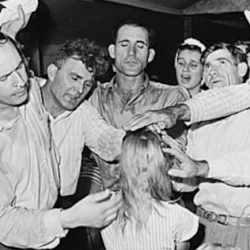In a contribution to the 1988 volume, Eliminating Racism, Thomas Pettigrew explained the uniqueness of the African-American experience, which “uniquely combines a long history of being simultaneously an integral part and on the outside of the society” (23).
Few of even the most racist Americans consider blacks to be un-American outsiders. They are acknowledged to be Americans, and they think of themselves as Americans: “They are neither immigrants nor aliens. Nor are they a colonized people in the full sense. Their arrival in Virginia in 1619 predates all but Indian Americans and the earliest British settlers. They are centuries removed from their homelands; and they are the one group in the United States that did not choose to come to the New World.” In short, they “were both accepted as belonging and yet racially denied their full rights as citizens.”
This is why the African-American experience cannot be fit into a generalized theories about colonized groups: “In contrast to most colonized peoples, for example, black Americans lack a population majority, a prior territorial claim, and a group history and culture sharply separated from the dominant group. They are both a part of and apart from the wider American society in a way unparalleled by other minority groups” (23).
Blacks don’t fit immigrant experience either. Like other ethnic groups in America, “Black Americans have an important and distinctive subculture. But this subculture differs from those of national ethnicities in two critical respects. First, it was shaped not in another part of the world but in North America for over 3 1/2 centuries. Second, the black subculture does not receive the recognition routinely granted most national ethnic subcultures; indeed, many whites even reject the idea of its existence. This lack of recognition persists in spite of the fact that blacks have contributed far beyond their numbers distinctive elements to the wider culture of the United States and the Western world more generally. Yet, blacks also share a language, a religion, and a broad national culture with other Americans” (23-4).
Pettigrew suggests that this is the opposite concern from European immigrants: “The new Europeans were seen as not ‘American“‘enough; the dominant pressure on them was to give up their strange and threatening ways and to assimilate. Blacks were Americans of a lower caste; the dominant pressure on them was to ‘stay in their place’ and not to attempt assimilation into the mainstream culture of the privileged” (24).
In sum, “the marginal status of black people in modern America differs in kind from the marginal status of other minorities. Save for West Indian migrants, blacks do not experience the traditional pull between another nation’s culture and American culture, for which the assimilation and pluralism concepts were specificalIy fashioned. Nor do they face charges of being ‘un-American’ and not belonging. Their marginal position is more complex, and the use of theory and concepts developed for the immigrant experience obscures more than it enlightens. Blacks’ marginalization is created by their being a long -term, integral component of American society while, at the same time, being denied the privileges that otherwise accrue to such a central position” (24).














